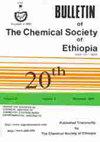Chemical composition and antibacterial activity of essential oils from selected species of the genus Cucumis in Ethiopia
IF 2.3
4区 化学
Q3 CHEMISTRY, MULTIDISCIPLINARY
引用次数: 0
Abstract
ABSTRACT. Chemical composition of the essential oils obtained by hydrodistillation from various parts of Cucumis ficifolius, Cucumis dipsaceus and Cucumis prophetarum were determined by gas chromatography-mass spectrometry (GC/MS) analysis. Compounds 3,7,11,15-tetramethyl-1-hexadecanol, neophytadiene, and isophytol from leaves, phytol and octacosane from the stems, hentriacontane from the fruits, and octacosane, abietadiene from roots were identified the major constituents of Cucumis ficifolius. Hydrocarbons including Octacosane, tricosane, tetracosane, hentriacontane and hexacosane were the principal components of various parts of Cucumis. dispaceus. While leaves, stems and roots of Cucumis prophetarum contain mainly hentriacontane, neophytadiene and octacosane, respectively. The oils were evaluated for their antibacterial activity using disc diffusion method against four bacterial pathogens including E. coli, P. aeruginosa, S. aureus and S. pyogenes. All tested essential oils were sensitive against the bacterial strains. The essential oil from the leaves of Cucumis dispaceus exhibited the highest inhibition zone against E. coli (11.87±2.42 mm) while the other displayed modest activity compared with the positive control, ceftriaxone. Therefore, the antibacterial activities displayed by the essential oils along with the literature reported for their constituents suggest the use of these plants as an antibacterial agent. Furthermore, the results presented herein also support the traditional use of these plants against bacteria. KEY WORDS: Cucumis ficifolius, Cucumis dipsaceus, Cucumis prophetarum, Antibacteria Bull. Chem. Soc. Ethiop. 2023, 37(3), 703-715. DOI: https://dx.doi.org/10.4314/bcse.v37i3.13埃塞俄比亚黄瓜属植物精油的化学成分及抑菌活性
摘要采用气相色谱-质谱联用(GC/MS)分析方法,对水蒸馏法提取的三种黄瓜(Cucumis ficifolius、Cucumis dipsaceus和prophetarum)不同部位精油的化学成分进行了测定。鉴定出叶片中的化合物3、7、11、15-四甲基-1-十六醇、新叶绿二烯和异叶绿醇,茎中的叶绿醇和八烷,果实中的十六烷,根中的八烷和二烯。八糖烷、三糖烷、四糖烷、十六康烷和六糖烷是黄瓜各部位的主要成分。dispaceus。而黄瓜叶、茎、根的主要成分分别为十六康烷、新叶二烯和八烷。采用圆盘扩散法对大肠杆菌、铜绿假单胞菌、金黄色葡萄球菌和化脓性葡萄球菌4种病原菌进行抑菌活性评价。所有被测精油对细菌菌株均敏感。与阳性对照头孢曲松相比,黄瓜叶精油对大肠杆菌的抑制区最大(11.87±2.42 mm),另一种精油对大肠杆菌的抑制区较小。因此,这些精油所显示的抗菌活性以及对其成分的文献报道表明,这些植物可以作为一种抗菌剂。此外,本文的研究结果也支持了这些植物抗细菌的传统用途。关键词:黄瓜,黄瓜,先知黄瓜,抗菌牛化学。Soc。阿比西尼亚人。2023年,37 (3),703 - 715 . DOI: https://dx.doi.org/10.4314/bcse.v37i3.13
本文章由计算机程序翻译,如有差异,请以英文原文为准。
求助全文
约1分钟内获得全文
求助全文
来源期刊
CiteScore
2.20
自引率
8.30%
发文量
113
审稿时长
6-12 weeks
期刊介绍:
The Bulletin of the Chemical Society of Ethiopia (BCSE) is a triannual publication of the Chemical Society of Ethiopia. The BCSE is an open access and peer reviewed journal. The BCSE invites contributions in any field of basic and applied chemistry.

 求助内容:
求助内容: 应助结果提醒方式:
应助结果提醒方式:


